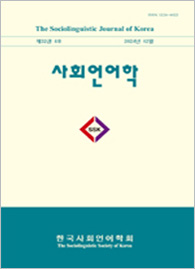![]() Journal Search Engine
Journal Search Engine
ISSN : 1226-4822(Print)
ISSN : (Online)
ISSN : (Online)
The Sociolinguistic Journal of Korea Vol.22 No.3 pp.116-133
DOI : https://doi.org/10.14353/sjk.2014.22.3.115
DOI : https://doi.org/10.14353/sjk.2014.22.3.115
A Proposal of a Resolution Method on the Confusion of Word Spacing in the Current Korean Orthography.
10월 15일
11월 1일~11월 30일
12월 10일
Abstract
The purpose of this study is to examine the way to minimize the confusions regarding spacing address and reference forms such as ‘씨’, ‘님’, ‘양’, ‘군’ and ‘가’ among Korean language speakers. This paper explains that the reason for this confusion starts from the fact that Korean language speakers usually interpret the principals for spacing arbitrarily.
As another reason for the confusion for spacing address and reference forms, this study examines perceptional changes among Korean language speakers. ‘님’, for example, was attached only to kinship terms at first. It’s usage, however, has been expanded by combining with common nouns or terms for relationships and positions and by being attached to family names or given names such. Through this procedure, the native speakers of Korean language seem like not only perceive the term as an honorific term but also consider it as a term which constructs its own meaning.
In this study, they are classified as bound nouns based on intuition of native speakers, independence rate, existence of practice before those words. Through this procedure, this paper tries to arrange the words as a united grammatical unit, and hence to minimize the confusion.
As another reason for the confusion for spacing address and reference forms, this study examines perceptional changes among Korean language speakers. ‘님’, for example, was attached only to kinship terms at first. It’s usage, however, has been expanded by combining with common nouns or terms for relationships and positions and by being attached to family names or given names such. Through this procedure, the native speakers of Korean language seem like not only perceive the term as an honorific term but also consider it as a term which constructs its own meaning.
In this study, they are classified as bound nouns based on intuition of native speakers, independence rate, existence of practice before those words. Through this procedure, this paper tries to arrange the words as a united grammatical unit, and hence to minimize the confusion.
Address and Reference Forms, Bound Noun, Suffix, The Rules of Korean Orthography, Spacing, The Norms of Korean Language
현행 한글맞춤법의 호칭어 띄어쓰기 혼란에 대한 해결 방안 제시 -‘(-)님’과 ‘(-)씨’를 중심으로-
초록
Figure
Table
Reference
Vol. 40 No. 4 (2022.12)

Frequency Published four times annually in March, June, September, and December
Doi Prefix 10.14353/sjk.
Year of Launching 1993
Publisher The Sociolinguistic Society of Korea



Online Submission
socioling.jams.or.kr
The Sociolinguistic
Society of Korea
socioling.com
Editorial Office Contact Information
- Tel: +81-10-3894-3164
- E-mail: schang@hoseo.edu






